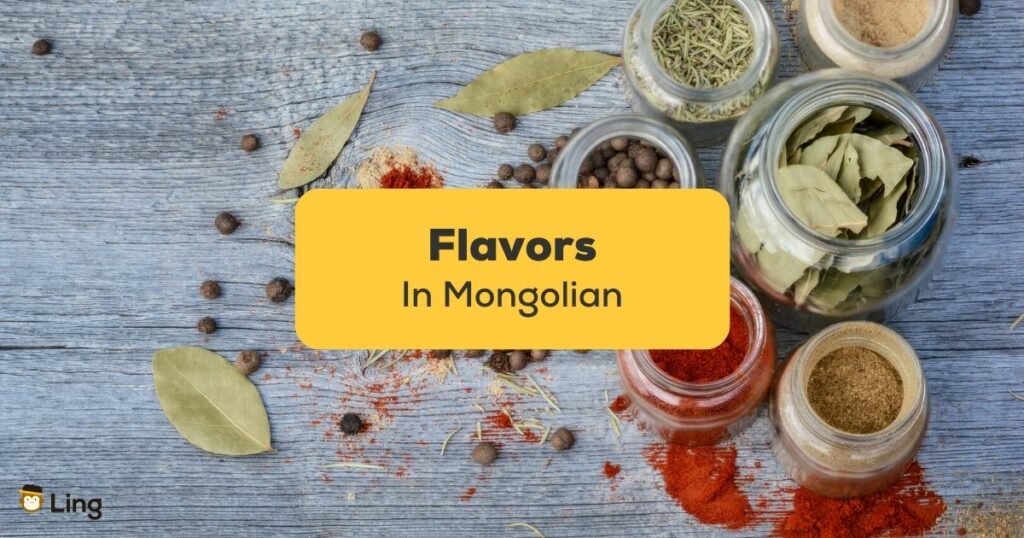If you’re a Mongolian foodie and a language enthusiast, there’s no better way to dive into a culture than through flavors in Mongolian! In this post we’re taking you on a culinary journey to Mongolia, where the taste of tradition is as rich as the landscapes that define the country.
So, grab your chopsticks and let’s explore the mouthwatering world of flavors in traditional Mongolian cuisine!
Top 6 Most Important Flavors In Mongolian
Like most of the cuisines around the world, Mongolians also include the most basic yet most important six flavors in their cooking. Let’s look at what they are known as in the Mongolian language.
| English | Mongolian | Transcription |
|---|---|---|
| Salty | Шар | Shar |
| Spicy | Хар | Khar |
| Sweet | Там | Tam |
| Sour | Тунгалаг | Tungalag |
| Bitter | Аян | Ayan |
Salty (Шар – Shar)
Salty flavors in Mongolian cuisine are like a warm welcome after a long journey across the steppes. Salt is not only a seasoning but also a preservative, essential for preserving meat and dairy products. Traditional dishes like “будаатай бяслаг” (budaa-tai byaslag), a savory milk tea, often include a pinch of salt to balance the flavors and enhance the natural taste of ingredients. Mongolians also have a variety of dried and preserved meats, collectively known as “бяслаг” (byaslag), which are enjoyed as snacks or accompaniments to other dishes.

Spicy (Хар – Khar)
For those who love a kick in their meals, Mongolian cuisine has a spicy side too. The heat comes from spices like red pepper flakes and black pepper, and is often used in hearty dishes to add warmth and depth. “Бууз” (buuz), steamed dumplings stuffed with minced Mongolian beef, are a popular dish that exemplify this flavor. A touch of spiciness in the meat filling elevates the dish and balances the flavors, especially when enjoyed with a dipping Mongolian sauce called “айраг” (airag), a fermented mare’s milk drink that cools down the heat.
Sweet (Там – Tam)
Sweet flavors in Mongolian dishes are a celebration of nature’s gifts. Honey and other natural sweeteners are commonly used in desserts like “өртөөт” (ortoot), a kind of pastry, and “ааруул” (aarul), a type of dried curd sweetened with brown sugar only. Mongolia’s vast landscapes provide the resources for these delectable treats, making sweet flavors a delightful reminder of the country’s natural richness.

Sour (Тунгалаг – Tungalag)
The tangy twist of sour flavors in Mongolian cuisine can transport you to the verdant pastures and pristine rivers that shape the land. Dairy products play a vital role in Mongolian cooking, and sourness often comes from fermented milk products like “туураг” (tuurag), a sour yogurt, and “аруул” (aruul), dried curd. These sour delights not only add complexity to the taste but also offer probiotic benefits, a testament to the resourcefulness of Mongolian nomads.
Bitter (Аян – Ayan)
Bitterness is a subtle yet essential note in Mongolian cuisine. “Өсөлт” (usult), a traditional stir-fry dish, might incorporate bitter greens, garlic and ginger, which provide a refreshing contrast to other flavors. Bitter herbs and vegetables are often enjoyed as salads or cooked into stews, adding a layer of complexity that reflects the diverse Mongolian landscape.

Mongolian Culinary Landscape
Mongolia’s cuisine is a reflection of its nomadic heritage, where the flavors are as vast and diverse as the landscapes they emerge from. The country’s harsh climate and vast pastures have influenced the way Mongolians cook and consume food. Ingredients like meat, dairy, and locally grown produce form the backbone of the cuisine, and the flavors we’ve explored are integral to balancing and enhancing these ingredients.
From the salty breeze of the Gobi Desert to the spicy heat of the bustling markets, the sweet rivers winding through the valleys, the sour tang of dairy traditions, and the bitter greens dotting the meadows – each flavor tells a story of survival, resilience, and the rich culture of Mongolia.
So, whether you’re savoring a steaming bowl of “цуйван” (tsuivan), a noodle dish with flank steak and vegetables, or relishing the succulent “хуушуур” (khuushuur), deep-fried meat pastries, remember that you’re not just tasting flavors, but also the history and soul of a nation. As you explore these flavors, you’re not just learning a language, but also immersing yourself in the heart of Mongolia.
3 Fun Facts About Mongolian Flavors & Cuisine

1. A Twist On Salty: Salted Milk Tea
Mongolia surprises taste buds with “будаатай бяслаг” (budaa-tai byaslag), a salty milk tea. Unlike the typical notion of sweet and soothing teas, Mongolians have crafted a savory blend with a pinch of salt. This warm and unexpected concoction not only warms the body but also delights with its comforting taste.
2. Spicy Delights
From the vast steppe emerges the unexpected, spicy flavors in Mongolian dishes. The steamed dumpling, known as “бууз” (buuz), feature a surprising twist with red pepper flakes and black pepper for seasoning the hearty Mongolian beef. This infusion of spice adds a zesty kick, showcasing Mongolian cuisine’s adaptability and creative flair.
3. Fermented Foods
Sour flavors in Mongolian dishes stem from the dairy delights that have stood the test of time. “туураг” (tuurag), a sour yogurt, and “аруул” (aruul), dried curd, bring tangy joy and probiotic benefits. Born from nomadic ingenuity, these fermented wonders were a practical solution to preserving dairy during long journeys, offering both nourishment and refreshment!
Learn Mongolian With Ling
Want to learn more Mongolian but don’t know where to find resources on this niche language? Step over to the Ling Mongolian blog to learn more about Mongolian culture & beginner phrases. And if you are really keen to learn all the language aspects of the Mongolian language, we have the most amazing Ling app for you!
Ling is a highly researched language-learning app for a fun and personalized experience. With Ling, you’ll smash your language goals with a little hard work and practice. Aside from Mongolian, there are over 60+ foreign languages to learn on Ling. So, download the free Ling app today from the App Store or the Play Store today!



































































